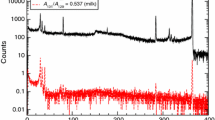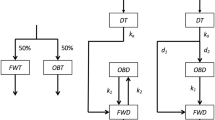Abstract
Radiochlorine38 was evaluated and found to be suitable for use as a tracer in studying the deposition of fat in porcinepanniculus adiposus tissue. Its short half-life makes its preparation from natural chlorine simple and inexpensive, and also minimizes long-term contamination problems, and its energetic beta and gamma rays makes its radio-assay simple and rapid. For swine, the threshhold level for a statistical counting accuracy of 1% was found to be approx 8 × 10−2 mc/lb of live wt. The time required for the digestion, absorption, transport and deposition of statistically sufficient detectable radioactive material was 3 1/2 hr. The incorporation of radiochlorine38 into lipid molecules does not appear to alter their normal metabolic pathways.
Similar content being viewed by others
References
Bloom, B., I. L. Chaikoff and W. O. Reinhardt, Am. J. Physiol.166, 451–455 (1951).
Burch, G. E., S. A. Threefoot and C. T. Ray, J. Lab. Clin. Med.35, 331–347, (1950).
Care, A. D., Proc. Roy. Soc. Med.48, 827–833 (1955).
Comar, C. L., “Radioisotopes in Biology and Agriculture,” McGraw-Hill, New York, 1955, p. 235–236.
Comar, C. L., Proc. Inter. Conf. on the Peaceful Uses of Atomic Energy,12, 245–251 (1955).
Comar, C. L., and R. H. Wasserman, Atomic Energy and Agriculture Symposium, Am. Assoc. Adv. Sci., Washington, 1957, p. 286–292.
Cowie, D. B., L. B. Flexner and W. S. Wilde, Am. J. Physiol.158, 231–236 (1949).
Glasstone, S., “Sourcebook on Atomic Energy,” 2nd ed., D. Van Nostrand, New York, 1958, p. 517–518.
Hevesy, G., Biochem. J.17, 439–445 (1923).
Hevesy, G., Enzymologia5, 138–157 (1938).
Hogan, C. A. M., Proc. Nat. Acad. Sci. (U.S.A.)37, 393–395 (1951).
Johannesson, J. K., Anal. Chem.34, 1111–1113 (1962).
Kamen, M. D., “Radioactive Tracers in Biology,” Academic Press, New York, 1947, p. 222–224.
Mead, J. F., and D. R. Howton, “Radioisotopic Studies of Fatty Acid Metabolism,” Pergamon Press, New York, 1960, p. 1–36.
Sink, J. D., J. L. Watkins, J. H. Ziegler and R. C. Miller, J. An. Sci.23, 121–125 (1964).
Sorensen, P., Anal. Chem.27, 388–390 (1955).
Sorensen, P.,Ibid. 28, 1318–1320 (1956).
Strajman, E., and N. Pace, Adv. Biol. Med. Phys.2, 193–241 (1951).
Threefoot, S. A., G. E. Burch and C. T. Ray, J. Lab. Clin. Med.42, 16–33 (1953).
Trum, B. F., J. N. Snively, U. S. G. Kuhn and W. T. Carll, Radiation Res.11, 326–342 (1959).
Author information
Authors and Affiliations
Additional information
Journal Series of The Pennsylvania Agricultural Experiment Station, Paper No. 2818.
About this article
Cite this article
Sink, J.D., Watkins, J.L., Ziegler, J.H. et al. Radiochlorine as a tracer in fat deposition. J Am Oil Chem Soc 42, 435–437 (1965). https://doi.org/10.1007/BF02635586
Received:
Accepted:
Issue Date:
DOI: https://doi.org/10.1007/BF02635586




